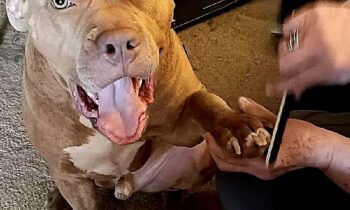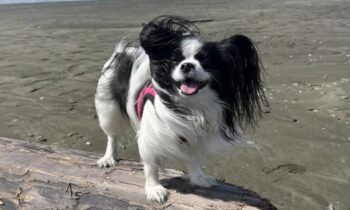
Carol Byrnes is a dog trainer who owns and operates a dog-training school in Spokane, Washington. Until recently, the animal family in Carol’s home consisted of one dog—Ellie, a 10-year-old spayed female Jack Russell terrier, adopted as an adult from the Airway Heights prison dog training program—and one cat: Nemo, a 16-plus-year-old spayed female Cornish Rex cat who’d been declawed prior to her adoption as an adult from the Spokane Humane Society.
Then . . . along came Arbee, Carol’s new puppy!
Nemo the cat had no previous dog experience years ago when she joined Carol’s family of three resident dogs and one cat. Nemo lived in Carol’s office behind a baby gate for many weeks. She has raised lots of dogs over the years since then.
Arbee, the puppy, eleven weeks old, is a mini Australian Cattledog/Jack Russell terrier mix.
Comparative size of pup vs. cat now?
Puppy is still smaller than the cat, but gaining fast.
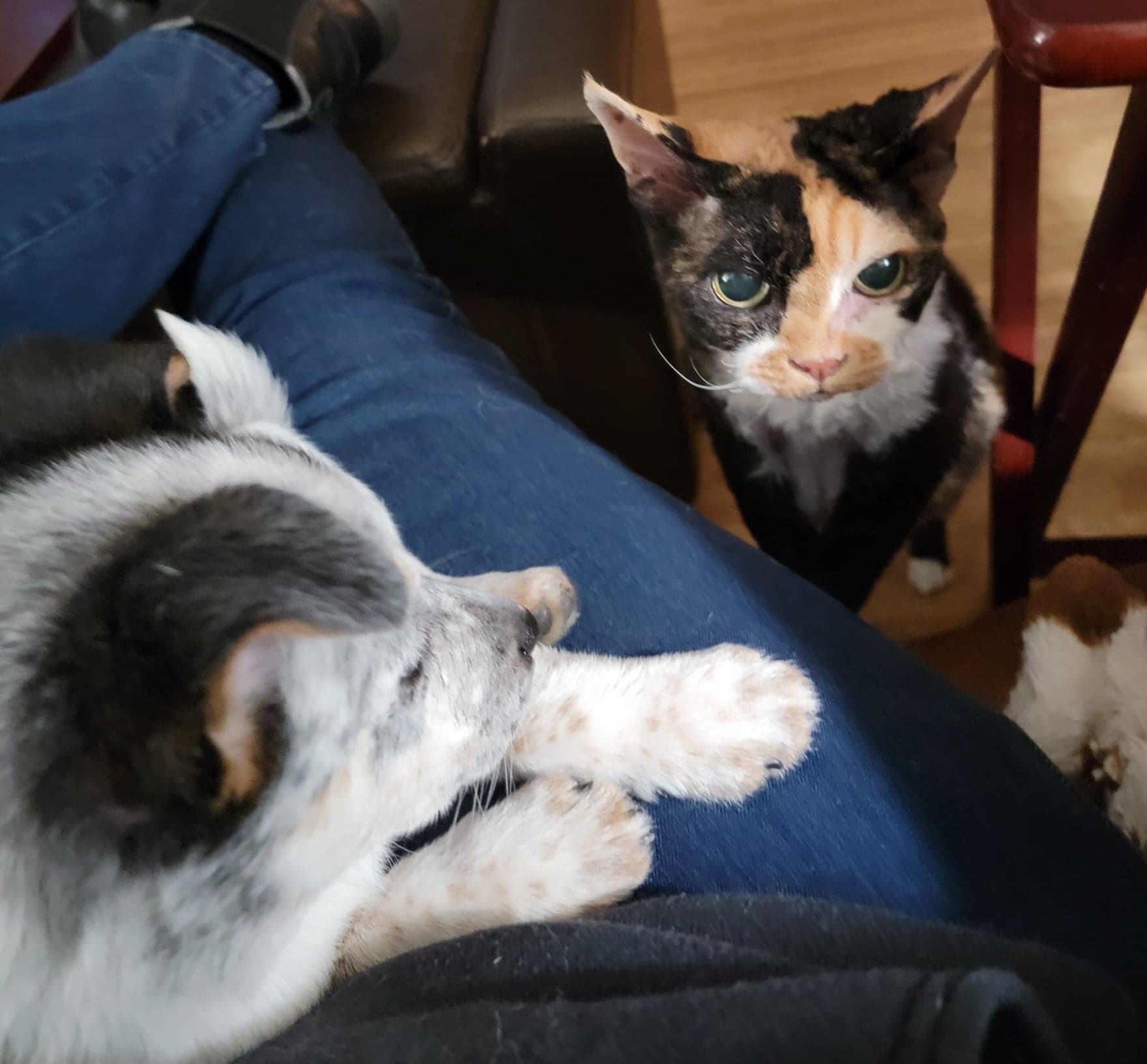
Photo by Carol Byrnes
I asked Carol some basic questions about introducing a new puppy to a resident cat.
What can prospective puppy parents expect from cats that are already members of the family?
How easy or difficult it will be depends entirely on the cats in question and their personalities and their experience with dogs. Expect even the most calm, dog-savvy cat to be mortified at first. There will be growling and hissing. This is how they set boundaries. The younger the puppy, the easier it will likely be. In her time with us, Nemo has lived with many dogs, but she growls and hisses and has been pretty sure for the first couple of weeks with the puppy that life as she knows it is ruined. (She is a drama queen.) Because she is dog-savvy, Nemo knows not to run from the puppy, and she has really clear rules and consistently reinforces them. As the days go by, Nemo allows the puppy to be a little bit closer to her, as she is ready. Nemo takes great pride in sitting in doorways and not allowing the puppy to pass.
How about if the cat has no experience with puppies?
Again, the younger the puppy and the younger the cat, usually the easier it will be. At a few weeks old, puppies may follow, but are less likely to chase; they can’t get on the couch or bed yet, which affords the cat more “puppy-free zones” where they can observe safely out of reach. If the pup is older, larger, and more agile, they may be much less respectful of the cat’s personal space. Attach a trailing leash and you can step on it as needed so the cat doesn’t get accosted by its new best friend. In case of emergency, grab the dog, not the cat. You do not want to wrap your arms around a cat who is in defensive mode unless you have a lot of Band-Aids® handy!
Any “training” for the cat that you’d suggest should be done well before the pup arrives?
If it’s possible, bring home a blanket or towel that the puppy has slept on and leave it where the cat generally hangs out, so the cat can become familiar with the scent of their new family member prior to meeting the puppy. It might not be possible to provide the actual puppy’s scent but, if the cat is not accustomed to dogs at all, perhaps you can “borrow” some dog scent from a friend’s dog. I also recommend Feliway® spray or diffuser to reduce kitty stress. Trim kitty nails to minimize damage if/when the puppy gets bopped in the face.
Any “training” for the puppy before he leaves his first home, if the breeder or foster has cats?
Best-case scenario, the puppy has met calm, dog-savvy cats from a very young age and has already imprinted that cats are family. You can hope that those cats have been good kitty ambassadors and puppy trainers. Crate training is important for all puppies. A crate-trained puppy can be investigated safely by the cat from the outside of the cage.
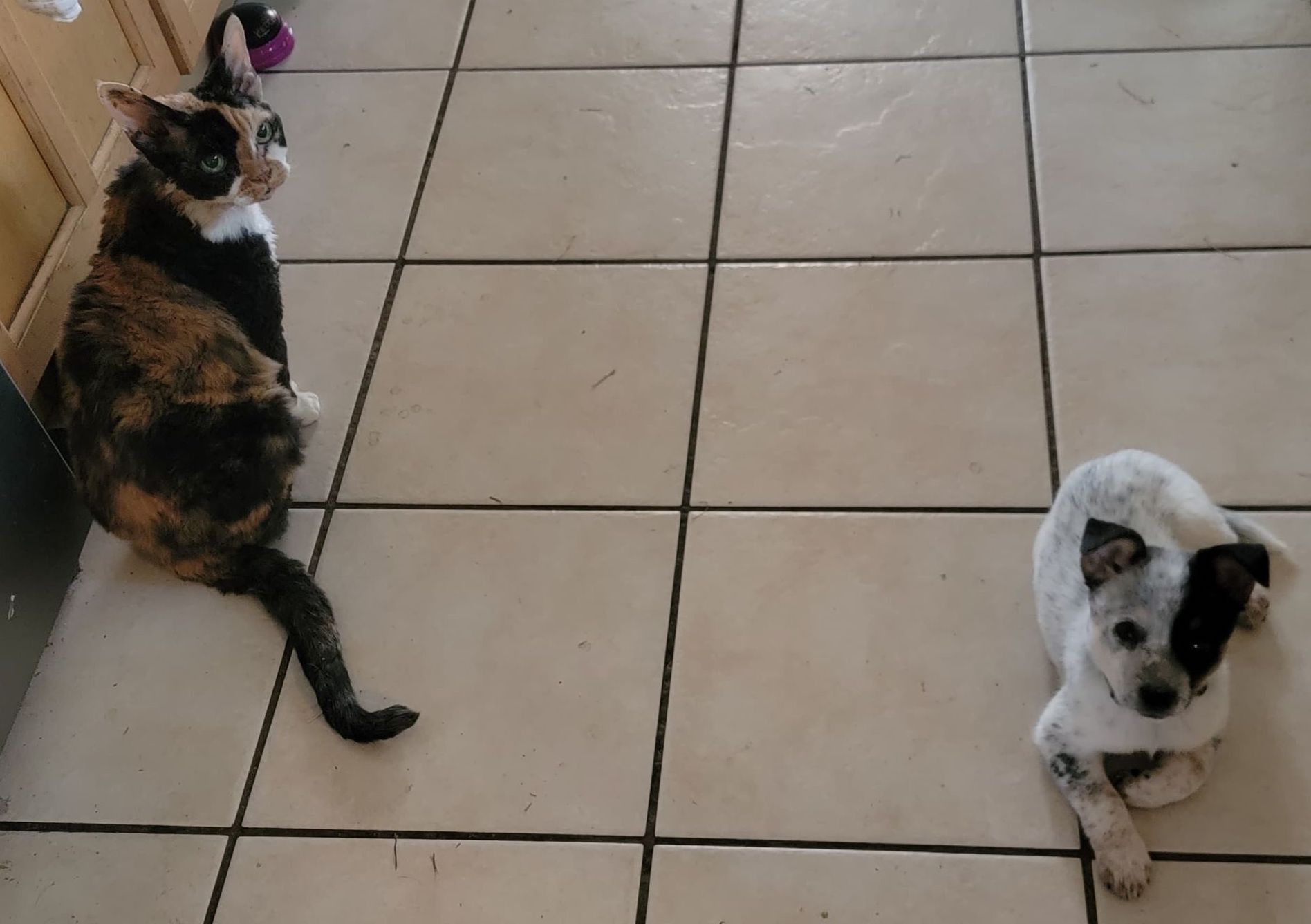
Photo by Carol Byrnes
Your suggestions for the best physical set-up in the home? What can be prepared before the pup arrives (which gives the cat a chance to get familiar with it first)? Baby gates, exercise pens, safe cat space inaccessible to dogs? Where will all the animals eat? Where will they sleep? How about “securing” the litter box? What cat toys will not be safe for a puppy? Etc.!
The most important recommendation is that the cat’s daily routine should be disturbed as little as possible. Routines and schedules should be honored. If any changes must be made, they should be made prior to the puppy’s arrival, especially if this means relocating food bowls or litter boxes. Puppies require diligent supervision and careful confinement when you are unable to supervise. A pen and/or crate allows the cat to have regular freedom of the house when the pup is confined. Limit the puppy’s access with baby gates that the cat can get over, but the puppy can’t. This way, the puppy can’t follow the cat into every room in the house and the cat can have plenty of privacy to do her cat things. (It will make potty training the puppy easier, too.) Make sure the cat has an undisturbed passage to get to food, water, litter box, and her favorite napping spots. If the puppy poses a problem for the cat to get to her bathroom, you may find that the cat will choose a different place to go. Your cat may be reluctant to play, as it could cause the pup to want to join in. Cat toys may be too small for most puppies and could pose a choking hazard. Even if the toys are safe, your cat will probably not want icky dog spit all over her toys. (Then again, if a puppy covers themselves in catnip, the cat may think they are a much more tolerable puppy!)
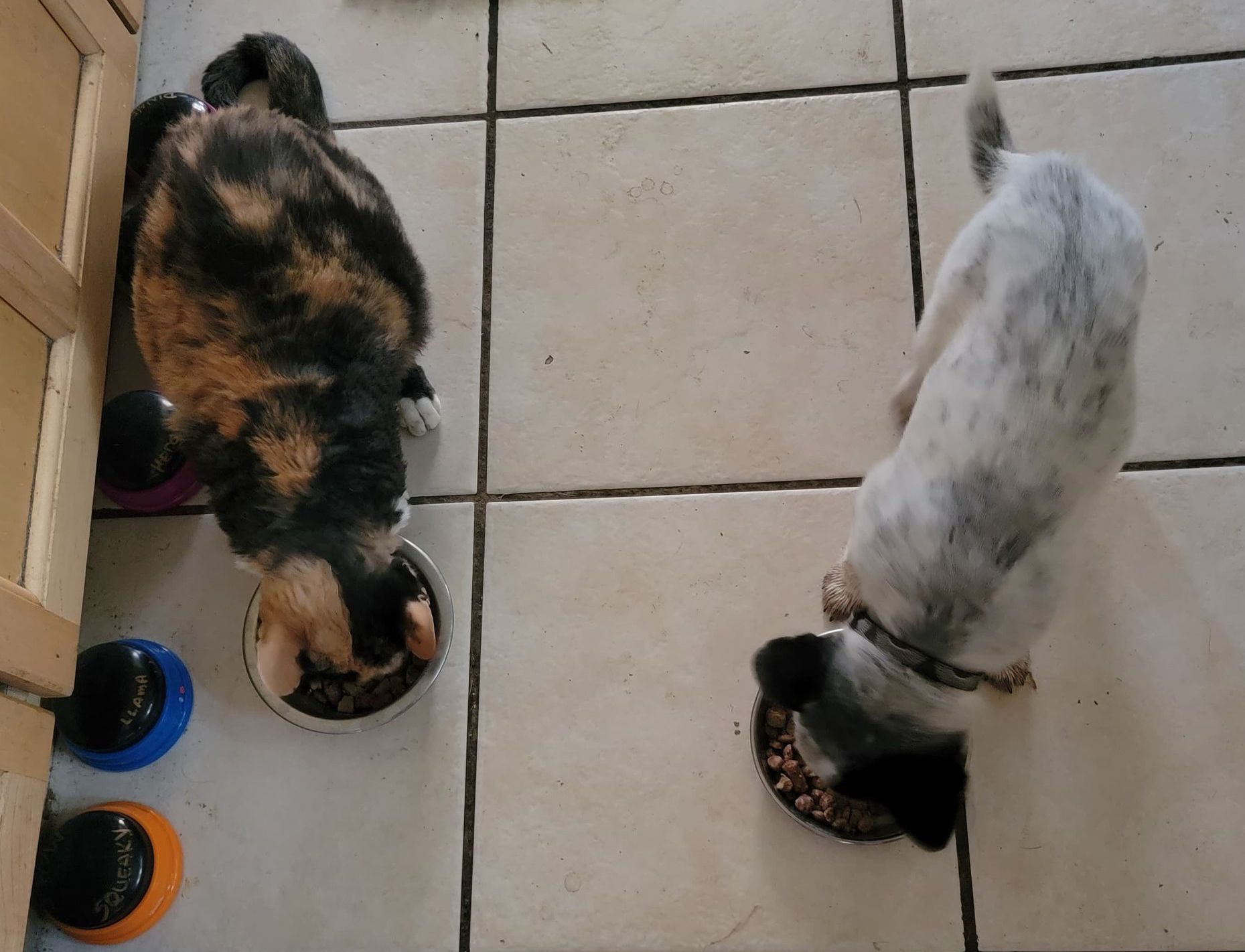
Photo by Carol Byrnes
What has been your plan from the beginning for your new pup with your resident cat?
Because our cat is so used to sharing our home with our dogs and hosting regularly visiting family and friends’ dogs, it was pretty much the status quo for Nemo, other than the exercise pen that went up a few days before the puppy’s arrival. We don’t interfere much, other than making happy chatter about how cool the new housemate is and occasionally redirecting the puppy to chase a toy when she’s too interested in the cat. We pet them both and let them smell our hands so they can get a good sniff of each other without getting too close. We praised Nemo when she’d sneak a sniff while the puppy was napping, but this was only when it was Nemo’s idea to approach on her own. Nemo’s normal life involves dogs, so nothing has been different other than it’s obviously apparent to her that this “visitor” isn’t going home.
What do you imagine might have happened already if you hadn’t had a plan?
No matter how much planning you do, there will always be adjustments to be made. It’s much easier to think ahead and to be prepared than to find cat poop in the laundry basket and a cat that won’t use its litter box, and have to undo long-term damage that could have been prevented!
What doesn’t work?
Don’t try to “help” them be friends. Making them sit next to each other or holding the cat for the dog to sniff is a bad idea. There are no shortcuts. It will take as long as it takes for the cat to adjust. It’s better to allow the cat distance and time to acclimate to the sights and sounds of the new dog. If the puppy blunders into the cat’s space and the cat has a cow, ignore the cat and congratulate the pup for leaving the scene. The sooner the small pup learns to move carefully around the cat, the better things will go when she becomes larger than the cat in a few weeks. DO rescue the pup if the cat is the aggressor.
When folks say, “Let them work it out on their own,” what can happen?
The question is always, “What do you want your pets to learn?” That cats are prey? That dogs are dangerous? Separate them during the puppy zoomie moments! Setting the stage to hang out calmly, day after day, is the best way for them to learn that the other animal is “no big deal.” That said, you can protect them too much. There is a certain amount of “educating” each other that can be productive. Puppies learn that cats are sharp and never to bounce on sleeping kitties! Cats learn that a little hiss is enough of a deterrent and it’s a waste of energy to get your panties in a bunch over every little thing. But unnecessary stress is counterproductive, especially if either the dog or cat are sensitive types. Don’t set them up to fail.
What are your immediate goals for the puppy and cat together? How about in the long term?
Things are going really well right now. The cat has taught the puppy what beds are cat beds and not to stick her nose in the cat bowl when the cat is eating. They have shared my lap on the couch! When the puppy is mature enough not to need to be confined when we aren’t home, I hope they will be calm and comfortable housemates and I will never have to worry about them being alone together.
Any surprises so far?
Only that it’s going so well, so quickly!
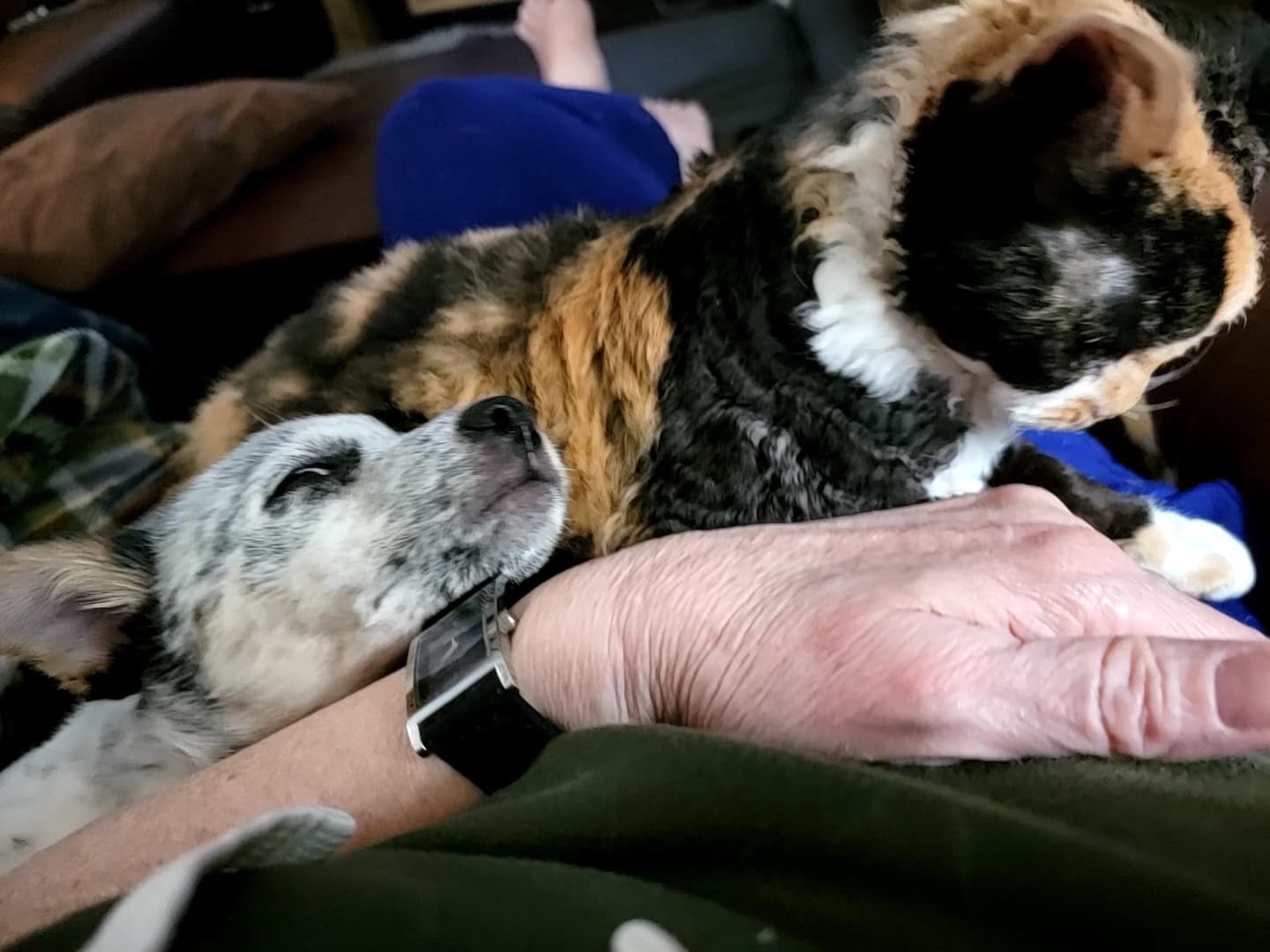
Photo by Carol Byrnes


